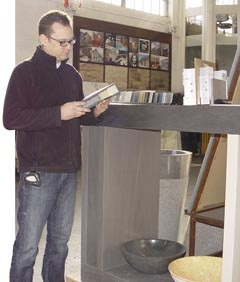Wholesalers : MGLW
Most of what MGLW sell are slabs of polished granite, marble, limestone and Compac engineered quartz. But they like to have a few surprises to interest clients and designers.
Being just the other side of the Thames from Chelsea, Belgravia and Kensington puts stone wholesalers MGLW within purchasing distance of some of the highest incomes not just in this country but in the world.
They and their designers are the sort of people with enough confidence in their own taste to be prepared to experiment and seek out the unusual. So MGLW are constantly sourcing the novel and exclusive for that market, which they supply only through the masonry companies that process and fix the stone.
Not all of MGLW’s business comes from the wealthy inhabitants of the fashionable areas of London, but it is a section of the property market that has remained a lot more active than most since the Credit Crunch devastated the sector. The continuing difficulties in the Eurozone are even increasing demand for property in London because it has become a more desirable place to live than Athens or Rome (for example).
“London is quite a particular market,” says Rogerio Moutinho, who runs the MGLW warehouse in close association with Manuel Almeida and Marcelo Carvalho.
The pictures on the left here show some of the more unusual stone products available from MGLW’s warehouse. The stone has been processed in Italy by Citco Marmi using the latest CNC machinery. The look of alligator skin, leopard skin (with dark marble set into a yellowish limestone) and bamboo are just some of the imaginative effects in stone the Italians have come up with.
MGLW can also find solutions for designers, such as the stone set into polished steel that Rogerio Moutinho is picture holding on the bottom right of these pages. Waterjet cutting was used to produce panels that MGLW sold for £1,300/m2.
Rogerio concedes that such products are not going to become best sellers but they do play an important part in establishing MGLW as the source of anything to do with stone. That helps make them the first port of call for a lot of designers and architects when they are looking for stone, as well as encouraging MGLW’s customers, who are the processors, to send their clients to the MGLW warehouse.
And those customers are not just from the top of the market nor even exclusively from the domestic market. There are also plenty of commercial premises that are still being refurbished.
“We are pushing MGLW as the one-stop centre for all your stone requirements. That encourages people to visit, which is rewarding because when they visit they see the variety available. That’s been very positive,” says Rogerio.
A visit to the warehouse to see large slabs of the materials they will be using also circumvents any problems of variations that will not necessarily be apparent from a small sample of the material. MGLW try to get the client or his agents in to see the stone on any order of more than 100m2 so everyone is clear beforehand about the variations there will be. Not that MGLW only supply 100m2 projects – they compete just as hard for the 20m2 sale.
And while MGLW sell only to stone processors, it is not just stone that they sell. Like most stone wholesalers these days, they also supply engineered quartz. MGLW’s comes from Compac in an association that goes back to before Compac opened their own warehouses in the UK in 2008. MGLW liked the Compac product and have stuck with it.
They also sell Ecopiedra, which is an easy to install man-made product that looks like stone for feature walls. And their latest addition is Sinterlite, a thin porcelain from Spanish manufacturers The Size, a company set up in 2009 to make this material.
Like quartz, which is generally credited with having doubled the size of the worktop market for stone processors by giving them an alternative to natural stone (which clearly some clients wanted), MGLW expect Sinterlite to complement rather than compete with their existing product range. And it is a product that requires the skills and machinery (if not the tools) of stone processors to work, so it should appeal to the wholesalers’ existing client base.
Sinterlite comes in 5mm and 3mm thicknesses. That means it can be built up to 8mm, which is the optimal thickness for work surfaces. Mitred joints create a drop at the front (see the pictures above right). And it is so robust it can even be used for both the inside and outside skins of curtain walling.
But natural stone is still the main part of MGLW’s business and the majority of what they sell is polished slabs of granite, marble and limestone, with MGLW’s stocks of marble increasing now that sales of it are growing again as stone makes more of an impact in bathrooms.
MGLW also supply stone tiles as a service to their customers to complement slab sales, although they say the tile market has become highly competitive with a massive increase in sales on the internet. Customers can easily buy directly from Spain, Portugal and Italy. And with the masons’ margins being squeezed ever tighter, even a small difference can seem attractive.
With slab it is different. Masons do not want to hold stock but do want instant access because lead times are still tightening. “They ask if we’ve got it. We say yes. They get their credit cards out and they want the slab delivered tomorrow,” says Rogerio.
Next year he is looking forward to the Olympic effect. “It will be a big buzz for London. Everyone will be happy. There will be a feel-good factor. I think that will have repercussions.”

